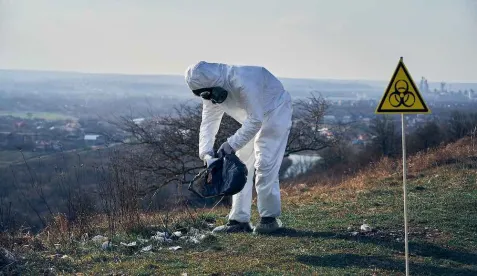Last week, the U.S. Environmental Protection Agency’s (EPA) Office of Enforcement and Compliance Assurance (OECA) released its annual enforcement report detailing the results of the past year’s civil and criminal enforcement and compliance efforts. The report covers the 2020 fiscal year, which ran from October 1, 2019, through September 30, 2020, and thus provides some key insight into the effect of the COVID-19 pandemic on environmental enforcement.
The takeaway points from the 2020 report include that EPA:
-
Assessed nearly $160 million administrative and judicial penalties, a decrease from the $365.9 million in 2019 (though just more than double the 2018 number), and secured injunctive relief worth approximately $2.95 billion, the smallest figure in a decade;
-
Initiated and concluded nearly 1,600 civil judicial and administrative cases, including 531 addressing potential environmental justice concerns. The number of cases continues a steady decline from the nearly 2,500 cases in 2016;
-
Secured 90 settlements and orders requiring parties to perform and/or pay for cleanup at Superfund sites, amounting to approximately $814 million;
-
Received 575 voluntary disclosures of violations under EPA’s self-disclosure policies covering 787 facilities, which marked significant decreases from the 1,901 facilities covered last year (in 635 disclosures);
-
Achieved 40 agreements by violators to perform Supplemental Environmental Projects (SEPs) totaling approximately $8 million in value. The SEPs figure is about a third of recent years’ totals, including last year, but is unsurprising given a policy announced by the U.S. Justice Department’s (DOJ) Environment and Natural Resources Division in March 2020 to prohibit the use of SEPs in civil judicial cases with private defendants;
-
Conducted approximately 3,000 on-site compliance inspections, greatly reduced from the approximately 8,000 performed in 2019 likely due to complications created by the pandemic. Inspections have been on a steady decline since 2014, however, when nearly 14,000 inspections were conducted;
-
Opened 247 criminal cases, 89% of which led to prosecution of an individual defendant, and obtained nearly $47 million in criminal fines, restitution, and court-ordered environmental projects, the smallest amount since 2012.
The report also details OECA’s activities related to its current National Compliance Initiatives (NCIs), areas the EPA has identified for particular focus of enforcement and compliance efforts in light of significant environmental violations or opportunities for the greatest environmental benefit. As we previously reported, the current NCIs are in place for fiscal years 2020 through 2023, and cover an array of environmental areas including: reducing air emissions from stationary sources and hazardous waste facilities, cracking down on aftermarket vehicle and engine parts violating emissions standards, addressing noncompliance with National Pollutant Discharge Elimination System permits and drinking water standards, reducing risks of accidental releases at industrial and chemical facilities, and addressing lead contamination across various media. However, there is nothing stopping the EPA from reassessing the NCIs to align with the policy preferences of the Biden-Harris Administration.
Overall, the numbers illustrate that EPA’s enforcement fell well below prior years’ numbers. That comes as no great surprise, however, particularly given the numerous temporary enforcement discretion policies the Agency instituted during the pandemic. We previously wrote about those policies here, here, here, and here. Nevertheless, OECA’s report claims EPA “was on track to significantly exceed traditional numeric metrics in many categories” prior to the pandemic’ onset. Indeed, issues directly related to the pandemic occupied a good bit of OECA’s focus this year, as the report details enforcement efforts—including 447 civil enforcement actions and opening approximately 60 criminal cases—to combat “the onslaught of violations of the Federal Insecticide, Fungicide, and Rodenticide Act (FIFRA) by persons hoping to cash in on the fear of the novel coronavirus by making fraudulent claims that their products or devices kill that virus.”
Effects of the COVID-19 crisis aside, the data also represent a continued trend over the course of the Trump Administration as EPA shifted its focus from emphasizing enforcement to more prominently focusing on compliance assistance and increasingly deferred to state-level enforcement. FY2020 represents the last full fiscal year under the Trump Administration, with the Biden-Harris Administration assuming control of EPA for the remainder of the current fiscal year. Although Michael Regan has been nominated to head the Agency, no nominee to lead OECA has been announced yet. With key personnel still unknown, it is difficult to read the tea leaves of potential enforcement priorities under new leadership. Based on President Biden’s campaign platform, however, regulated entities should generally expect more enforcement (e.g., inspections, requests for information, administrative enforcement and referrals to DOJ) and a focus on rebuilding EPA’s depleted staff and resources. Also, we expect EPA to generally take a more stringent view toward enforcement for environmental violations, with a focus on advancing its goals related to climate change and environmental justice. Any such efforts will become clearer in the coming weeks and months, with the initial results apparent in next year’s annual enforcement report. Companies should, as always, maintain compliance with all applicable environmental laws and endeavor to stay apprised of developments on the federal enforcement front.






 />i
/>i
